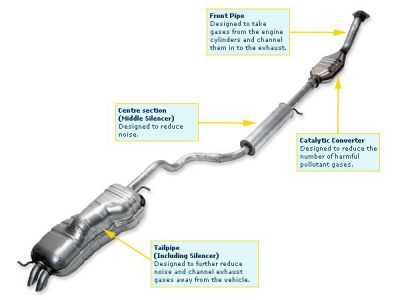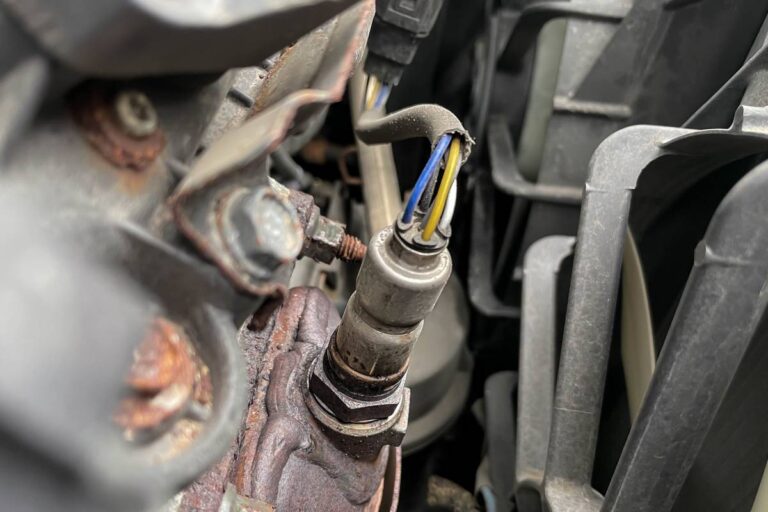Exhaust System Parts: Unleash the Power Within
The main parts of an exhaust system include the manifold, catalytic converter, muffler, and tailpipe. The exhaust system is an integral component of a vehicle, responsible for removing harmful gases from the engine and reducing noise.
The manifold collects exhaust gases from the engine cylinders, while the catalytic converter converts harmful pollutants into less harmful substances. The muffler controls noise by decreasing sound waves and the tailpipe releases the exhaust gases outside the vehicle. Each part plays a crucial role in ensuring the engine operates efficiently and the vehicle meets environmental regulations.
By understanding the various components of an exhaust system, one can better appreciate their importance and the impact they have on a vehicle’s performance.
The Role Of An Exhaust System
The role of an exhaust system in a vehicle is often overlooked, but it plays a crucial role in the overall performance and power output. An efficient exhaust system is important for several reasons.
- Improved Engine Performance: A well-designed exhaust system allows for the smooth exit of exhaust gases, reducing backpressure. This, in turn, improves the engine’s efficiency and power output.
- Enhanced Fuel Efficiency: An efficient exhaust system helps in maintaining the optimal air-fuel ratio, thus improving fuel efficiency. It ensures that the engine is not wasting fuel by burning a rich mixture.
- Increased Engine Lifespan: An improperly functioning exhaust system can lead to the accumulation of harmful gases and chemicals in the engine. This can cause damage to various engine components, reducing their lifespan.
- Reduced Environmental Impact: A properly functioning exhaust system helps in reducing harmful emissions, such as carbon monoxide and nitrogen oxide, which contribute to air pollution and global warming.
In summary, an efficient exhaust system plays a vital role in enhancing engine performance, improving fuel efficiency, extending the engine’s lifespan, and reducing environmental impact. It is important to ensure regular maintenance and replacement of exhaust system parts to enjoy these benefits.
Understanding The Components
Exhaust System Parts play a significant role in the overall functioning of a vehicle. Understanding the components is essential for maintaining and optimizing the performance of the exhaust system.
The Exhaust manifold is a vital component that collects the exhaust gases from the engine cylinders and directs them towards the rest of the exhaust system. It ensures proper flow and prevents backpressure, which can impede the engine’s performance.
A Catalytic converter is another important part of the exhaust system. Its main function is to reduce harmful emissions by converting harmful gases into less harmful substances through chemical reactions.
The Muffler, on the other hand, plays a crucial role in minimizing the noise produced by the engine. It contains sound-absorbing materials that help to reduce the noise level and provide a quieter driving experience.
Modern exhaust systems also use DPF (Diesel Particulate Filter) and SCR (Selective Catalytic Reduction) technologies. DPF helps to trap and remove diesel particulate matter, while SCR reduces nitrogen oxides by injecting a urea-based solution into the exhaust stream.
O2 sensors, also known as oxygen sensors, monitor and optimize the air-to-fuel ratio in the engine. They provide feedback to the engine control unit, enabling it to adjust the fuel injection for efficient combustion and reduced emissions.
Enhancing Performance With Upgrades
Upgrading your exhaust system can significantly enhance your vehicle’s performance. High-flow exhaust manifolds play a crucial role in maximizing exhaust gas flow, allowing for improved engine efficiency and power. Performance catalytic converters are another upgrade option that helps balance emissions and power, ensuring compliance with regulations while still optimizing performance. When it comes to sound and flow, performance mufflers and resonators can boost both, giving your vehicle a more aggressive and powerful tone while also improving airflow. For those looking to further optimize performance and efficiency, DPF and SCR delete kits are available, removing restrictive components and increasing power output. Lastly, O2 sensor reprogramming can improve engine performance by optimizing fuel-air mixture ratios, resulting in better overall efficiency and power. With these upgrades, you can take your vehicle’s performance to the next level.
Choosing The Right Exhaust System Parts
When selecting exhaust system parts, there are several key considerations to keep in mind. First and foremost, ensure that the components you choose are compatible with your specific vehicle model. Each car is unique, and using parts that are not specifically designed for your vehicle can result in poor performance and potential damage.
Another important factor to consider is your budgetary constraints. Exhaust system parts can vary widely in terms of price, so it’s crucial to establish a budget beforehand. Balancing your desired performance gains with noise levels is also important. Some exhaust systems may provide significant horsepower and torque increases, but they may also result in excessive noise, which may not be suitable for your preferences or local noise regulations.
Lastly, it’s crucial to ensure that the exhaust system parts you choose are legal and compliant with emissions regulations. Installing aftermarket parts that do not meet these standards can result in fines and potential legal issues.
Installation And Maintenance Tips
When upgrading your vehicle’s exhaust system, it’s important to ensure proper installation and ongoing maintenance. For complex systems, seeking professional installation and guidance is crucial. A professional installer has the expertise to handle intricate components and intricate connections, ensuring a seamless fit. However, if you’re looking to make simple upgrades on your own, there are a few tips to keep in mind.
- Before starting any installation, familiarize yourself with your vehicle and its exhaust system.
- Follow manufacturer instructions carefully, especially regarding torque values and assembly order.
- Regularly inspect for any leaks, loose connections, or signs of wear and tear.
- Perform routine maintenance tasks such as cleaning, lubricating, and replacing damaged parts.
By following these DIY tips and establishing a regular maintenance routine, you can keep your exhaust system in optimal condition and troubleshoot common issues efficiently. Remember, a well-maintained exhaust system not only improves performance but also contributes to a quieter and more environmentally friendly driving experience.

Credit: houseofharleydavidson.com
Frequently Asked Questions For Exhaust System Parts
What Are The Components Of The Exhaust System?
The components of the exhaust system include the exhaust manifold, catalytic converter, muffler, and tailpipe. They work together to expel exhaust gases from the engine and reduce noise.
How Many Parts Are In A Exhaust Pipe?
An exhaust pipe typically consists of several parts, including the exhaust manifold, catalytic converter, resonator, and muffler. These components work together to facilitate the flow of exhaust gases from the engine to the outside atmosphere.
What Is Connected To The Exhaust Pipe?
The exhaust pipe is connected to the muffler, which helps reduce noise, and the catalytic converter, which reduces harmful emissions.
Are Exhaust System Parts Expensive?
Exhaust system parts can vary in price but generally tend to be on the expensive side. Factors such as the brand, quality, and type of part can influence the cost. It’s important to take into consideration the long-term benefits and durability before making a purchase.
Conclusion
To sum up, maintaining your exhaust system is essential for the longevity and performance of your vehicle. Understanding the various parts and their functions can help you identify and address any issues that may arise. Regular inspections and proper maintenance will ensure that your exhaust system runs smoothly and efficiently.
By taking the time to care for your exhaust system, you’ll be able to enjoy a quieter, cleaner, and more fuel-efficient ride.








